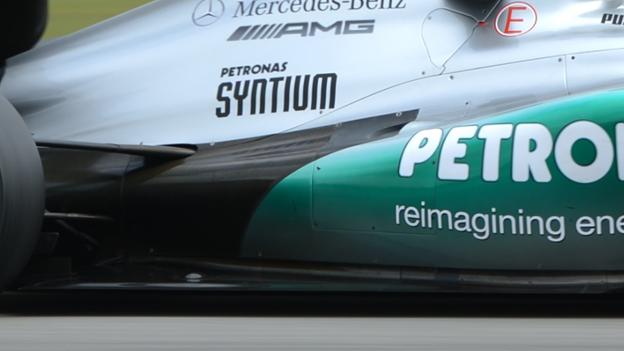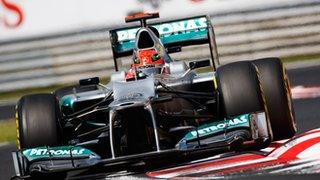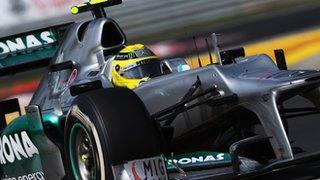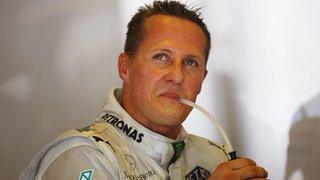Why Mercedes are struggling
- Published

Mercedes
The Hungarian Grand Prix was a new low for Mercedes in a season that, over the last few races, has been a story of consistent decline.
It was, first of all, a bit of an embarrassing race for Michael Schumacher.
The aborted start was caused by him stopping in the wrong grid position. He then erroneously switched his engine off - thinking of procedures that applied in the last decade when he was at Ferrari but which have now changed because of different rules.
Starting from the pit lane, Schumacher then got a puncture and incurred a speeding penalty when he came in for new tyres.
But those are just simple mistakes. Much more concerning has been the team's general downward trend in competitiveness.
Mercedes started the season promisingly, with some good qualifying results at the first two races, and then took a dominant win with Nico Rosberg at the Chinese Grand Prix.
At that time, there was a lot of attention on their clever 'double DRS' system.
This links the rear-wing drag-reduction overtaking aid that is on all cars with the front wing to give an extra boost in straight-line speed by reducing the front wing performance as well as the rear.
Back in March, the system aroused a lot of controversy, as many of Mercedes' rivals thought it was illegal - and still do.

Michael Schumacher at the Hungarian Grand Prix
When the FIA declared they were happy with it, the expectation was that the other top teams would quickly follow suit. But that hasn't happened.
In the meantime, things have gone downhill for Mercedes. Apart from a strong showing in Monaco, they have never looked close to winning again, and in the last few races they have got slower and slower compared to the other teams.
The nadir was Hungary, where Rosberg and Schumacher qualified 13th and 17th and the car was nowhere near the pace.
Even when the car was qualifying in the top six or so, there was a general trend to Mercedes's weekends - the car was much more competitive in qualifying than in the race.
That has changed a little in recent races but at the same time the car's general competitiveness has gone backwards.
That's because they have developed themselves in a direction to go slower, all because they have been trying to get more consistency from the rear tyres to help race performance. And that is linked to the 'double DRS'.
WHAT WAS THE INITIAL PROBLEM?

Rosberg in Hungary
Let's analyse what I believe are potential flaws in the 'double DRS', and then work out what has gone wrong as Mercedes tried to fix them.
To do that, we have to start with its benefits.
First of all, the system flatters the car in qualifying, when DRS use is free.
Firstly, because of the extra straight-line speed boost it provides by reducing drag.
And secondly because it balances the car in certain fast corners that, normally, a driver cannot take flat because the car would have too much oversteer (when it feels like it's going to spin). Reducing the effectiveness of the front wing makes the car less 'pointy', so the driver can go through those corners faster.
But in the races, drivers can use DRS only in the designated zone, and only when they are within a second of the car in front.
So because the 'double DRS' was helping Mercedes in qualifying, they will automatically lose more pace relative to the other cars in the race, when it is generally not available.
Quite apart from flattering the car in qualifying, there are also some significant compromises to the system itself.
Firstly, it creates an inherent understeer in the car - lack of front-end grip - because when the driver closes the DRS as he brakes for the corner, the rear wing immediately goes back to producing its maximum downforce, so the rear grip returns immediately, whereas the front wing has a slight delay.
That's because the front wing is connected to the rear wing by a series of pipes running the length of the car.
Before the front wing can work at its full effectiveness, the pressure under it - which includes the volume of air that is in the pipes to the rear wing - has to reduce. Only then will the underside of the front wing reach its lowest pressure, and create the most downforce and grip.
That delay does not happen in the race, because the DRS is not in use, so the car becomes 'oversteery'. So in the first part of the season Mercedes were suffering with a loose rear end in races, which created excessive rear tyre degradation.
HOW HAVE MERCEDES TRIED TO FIX IT?
To solve that rear tyre wear problem, since the Canadian Grand Prix in mid-June Mercedes have removed quite a lot of the downforce-producing devices on the front wing and are never running anywhere near maximum front wing angle.
That reduces the amount of front grip. They've probably lost something like 50-60kg of front downforce so they are running the centre of aerodynamic pressure much further rearward.
The benefit of that is that it will balance the car better so tyre degradation will reduce. But it comes at the cost of a slower overall pace. So the car feels better to drive, but is slower.
WHY WAS HUNGARY SO BAD?

Michael Schumacher looks on in Hungary
In the context of all this, it is clear why Hungary was Mercedes's worst circuit so far.
Both Rosberg and Schumacher were complaining of mid-corner understeer there.
There are very few big braking zones at the Hungaroring - most of the corners are preceded by short braking episodes. So the delay in the front wing working at maximum effect has a greater impact.
The driver wants to turn in on the brakes there, but the period of reduced effectiveness of the front wing means he does not have the front grip he needs as he turns into the corner.
In the race, Rosberg was more competitive. That will be because DRS can't be used as much, so the initial understeer isn't as big because the front wing is working more effectively sooner.
HOW CAN MERCEDES SOLVE THE PROBLEM?
Mercedes have a very conventional rear-end aerodynamic treatment and are not trying to exploit the exhaust gases for aerodynamic effect in the way McLaren, Ferrari and Red Bull are.
There is 0.2-0.3 seconds a lap in trying to do that - all produced from greater rear-end grip.
So if Mercedes want to improve, they would be better advised to build that kind of exhaust system. That would give them better rear-end grip, which would enable them to put the front downforce back on without suffering the rear instability they had earlier in the year.
And that would give them more overall downforce and the car would go quicker.
If I was them, I would be thinking very seriously about getting rid of the 'double DRS', unless I was absolutely on top of which circuits it will provide a benefit at and which it will create a deficit.
Hungary was probably the circuit where it will affect them most, because of those short braking zones. The next race is at Spa, where the double DRS will provide some benefits, because there are long straights and some kinks where it will be beneficial to run with the DRS open.
But you have to question, on the evidence of the season so far, whether having it is leading them up a blind alley in terms of their development direction.
Gary Anderson, the former technical director of the Jordan, Stewart and Jaguar teams, is BBC F1's technical analyst